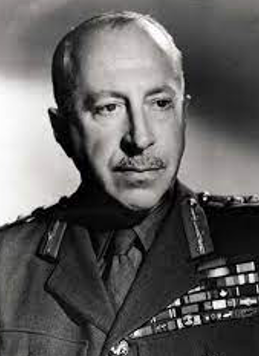
1888 - 1965
Harry Crerar entered RMC in 1906 after attending Upper Canada College and Highfield School in Hamilton. After graduating from RMC, he joined the militia and, over the course of WWI, he served in a number of key command and staff appointments, rising through the ranks to Lieutenant-Colonel by the end of the war. He was awarded the DSO as a result of his efforts as Acting Commander of an artillery brigade during the final phases of the Vimy Ridge Campaign. At the end of the war, he was demobilized from the militia, but subsequently joined the Permanent Force.
Following graduation from Staff College in England, Crerar accepted a posting with the War Office in London as General Staff Officer 2. In 1929, he was appointed General Staff Officer 1 at Army HQ in Ottawa and began work on a major reorganization of the Canadian Militia. He was appointed Director of Military Operations & Military Intelligence in 1935, and Commandant of RMC in 1938. His appointment was cut short in October 1939 as WWII began, and he was posted to London as brigadier on the General Staff at the newly formed Canadian Military Headquarters.
In July 1940, he was called back to Ottawa as Vice-Chief General Staff but promoted a few days later to Chief General Staff. In that year, he oversaw the rapid expansion of the Army and its upgrading from top to bottom, including Army HQ, the improved preparation of officers, men and equipment heading overseas, and the implementation of emergency recruitment and training programmes for territorial defence.
In December 1941, back in England, Crerar was appointed General Officer Commanding, 1st Canadian Corps. Following the ill-fated Dieppe raid in 1942, the 1st Canadian Infantry Division was absorbed into the 1st Canadian Corps as it engaged in the Italian campaign in 1943 with Crerar in command. In early 1944, he was recalled to England to replace General McNaughton as Commander of the 1st Canadian Army, the first Canadian to be promoted to full General while commanding troops fighting in war.
The 1st Canadian Army arrived in Normandy from England on 23 July 1944, and, under Crerar's command, played a major role as the Allies circled German troops in the Falaise Gap in August 1944. In February 1945, with the 1st Canadian Army on their northern flank, the Allies advanced to the Rhine. When the Allies launched the Rhineland campaign, General Crerar was leading a 450,000-man army, including allied formations, under 1st Canadian Army command.
After the war, Crerar oversaw the demobilization process. He retired from the military in 1946. Later, he occupied diplomatic postings in Czechoslovakia, the Netherlands and Japan. He was named Aide-de-Camp General to the King in 1948, and to the Queen in 1952, and appointed to the Queen's Privy Council for Canada in 1964.
In the words of historian J.L. Granatstein, "No other single officer had such impact on the raising, fighting, and eventual disbanding of the greatest army Canada has ever known".
Plaque inscription:
Soldier, WW I Field Commander, WW II Commander of the Canadian Army, Diplomat